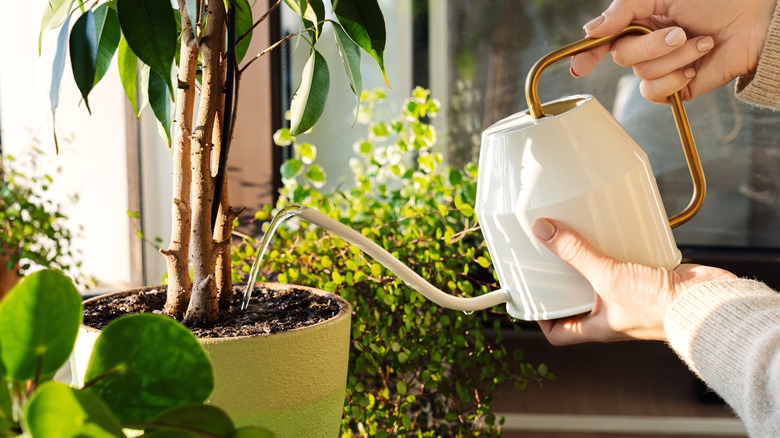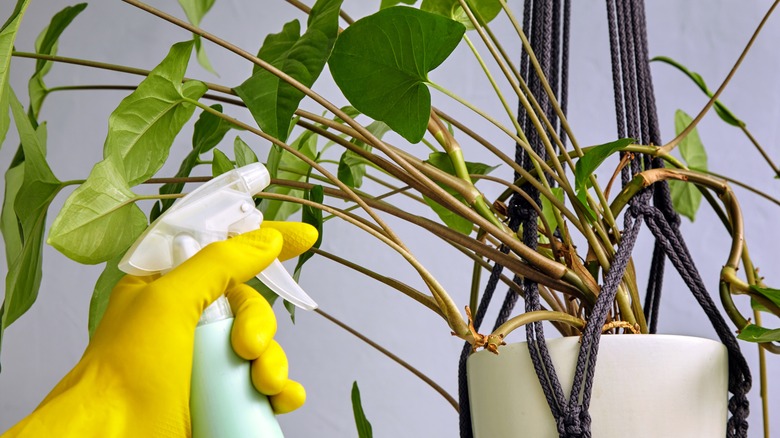The Medicine Cabinet Staple That Can Help Keep Houseplants Thriving
Many gardeners swear by the miracle of hydrogen peroxide for your plants, saying the medicine cabinet staple can cure root rot, kill mites, and even perk up droopy houseplants. But what is the truth about hydrogen peroxide and your houseplants? Let's dig in.
Hydrogen peroxide, discovered in 1818, is a clear, odorless disinfectant that's been used by school nurses and healthcare professionals for decades to kill germs around cuts and scrapes. It's safe to use on skin in solutions of 3%, which is the concentration of the big brown plastic bottle usually found on the shelf at your favorite drug store. You can also find it in your laundry detergent since it can whiten clothes and dissolve stains.
Videos all over social media show people showering their plants in a hydrogen peroxide mixture for thrifty, DIY plant food, but does it work? The short answer is yes, with caveats. You can use hydrogen peroxide for boosting plant growth. It helps make healthier roots, and it also prevents root rot. As an added bonus, it kills pesky pests like aphids and mealy mites. It is a cheap and easy way to give your houseplants a much-needed jump start, but only when used in the right concentrations. Don't overdo it, or you can end up with burned leaves or worse. And keep in mind that nothing is a cure-all. For beloved houseplants, hydrogen peroxide can give them a little boost, as long as you don't go overboard.
How to properly use hydrogen peroxide on plants
It's important to always mix hydrogen peroxide with water first. Never pour pure hydrogen peroxide directly on your plants, or you risk leaf burn. The ratio of hydrogen peroxide to water really depends on what you hope to accomplish.
To use it as plant food, one teaspoon per gallon is a safe mixture for healthy plants. This can give roots a boost by helping them absorb oxygen. If you're looking to treat root rot, then up the concentration to one part hydrogen peroxide to four parts water. Drench the soil in the solution, but also make sure there's good drainage because soggy soil might have caused that root rot in the first place. Also, don't rely on hydrogen peroxide to save a very sick or dying plant. Hydrogen peroxide is better used as a preventative than a cure and might not be able to reverse serious damage.
Also, not all plants love hydrogen peroxide. Young seedlings or delicate plants might wither if you use this chemical on them. Orchids in particular likely won't take kindly to a spray of hydrogen peroxide, which can cause burning of their leaves. With most plants, overuse of hydrogen peroxide can damage roots or even bleach out the soil, killing not only the bacteria that cause root rot but also healthy bacteria that the plant might need for nourishment.
Do this to use hydrogen peroxide to kill pests
For certain pests, hydrogen peroxide can be used as a spray. A hydrogen peroxide solution can kill pesky pests like aphids, mealybugs, or mites. When the solution touches them, it rapidly changes into water and oxygen, destroying insects at the cellular level. When sprayed on eggs or larvae, hydrogen peroxide rapidly dissipates all the oxygen as well, which can suffocate them.
To create hydrogen peroxide for a garden bug spray, use one part hydrogen peroxide (your typical 3% concentration) and three parts water. For a big infestation, try upping the concentration to one part hydrogen peroxide and two parts water. You can spray the insecticide on your plants, just be sure to test in a small area before going hog wild. Hydrogen peroxide can also kill sooty mold started by aphids when sprayed on affected leaves.
This pesticide might also shoo away mosquitoes in your garden. Spray the concentration of hydrogen peroxide around your patio or deck, or add it to standing water to kill mosquito eggs or larvae. Hydrogen peroxide can be helpful as a disinfectant, too. Learn how to wash fruits and vegetables with peroxide, especially those from your garden that might've been growing in manure or other bacteria-prone spots. When using hydrogen peroxide, use it in moderation, never ingest it, and avoid eye contact. If it does get in your eye, immediately flush with water or saline solution.

